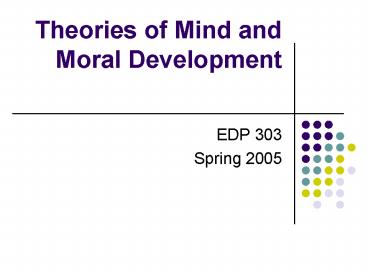Theories of Mind and Moral Development - PowerPoint PPT Presentation
1 / 15
Title:
Theories of Mind and Moral Development
Description:
Extended Piaget and focused on Cognitive development. ... about their concept of good and bad, right or wrong (cognitive dissonance) ... – PowerPoint PPT presentation
Number of Views:86
Avg rating:3.0/5.0
Title: Theories of Mind and Moral Development
1
Theories of Mind and Moral Development
- EDP 303
- Spring 2005
2
Kolbergs Moral Development
- Extended Piaget and focused on Cognitive
development. - Used Moral Dilemmas (most famously Heinz and the
drug) - Found 6 stages in the development of moral
reasoning.
3
I - Pre-conventional - Accept what you are told,
morals are not internalized yet.
- Level 1 - Punishment/reward orientation.
- Pain/pleasure not meaning is important.
- Level 2 Exchange of favors
- exchange notion of why we do what we do.
- Still define right or wrong based on consequences
to self.
4
II - Conventional - Adolescence, Primary goal
Maintain social order
- Level 3 good child orientation
- What is approved of by others is good.
- Level 4 Law Order
- do the right thing because it is right and it
maintains social order. - Rules should always be followed
5
III - Post Conventional - Autonomous level,
universal moral values regardless of group
membership.
- Level 5 Social welfare/human rights
- Good is determined by a society. People agree to
stick to these agreed-upon standards of morality.
- Level 6 Universal ethical principles,
- moral judgment based on justice equality of human
rights and respect for the dignity of humans as
individuals. - Rare level achieved by those who make decisions
on abstract matters of justice, individual
rights, etc.
6
Kohlbergs Critics
- Kohlberg
- Critics argue that Kohlberg's Stages 4, 5 and 6
reflect a single level--the ability to
systematically analyze a situation from different
philosophical viewpoints, with more liberal views
scoring higher. - Critics have also argued that Kohlberg does not
address gender and cultural differences, but
chooses a "white male" ranking. - Moral Reasoning does not always lead to moral
behavior.
7
Three aspects of morality
- Moral Reasoning
- Moral Motivation
- Moral Behavior
8
Social Understanding and Morality
- Morality is a social thing.
- More specifically, however, moral reasoning,
moral motivation, and moral behavior require the
development of Social Cognition.
9
Theories of Mind
- We are not born with a theory of mind
- Early on infants understand that humans are
special objects in their world. - Toddlers dont really understand independent
thought.
10
Answer this Question like a 3 year old
- Max puts a piece of chocolate in the kitchen
cupboard and then goes out to play. While he is
gone, his mother discovers the chocolate and move
it to a drawer. When Max returns later, where
will he look for his chocolate?
11
Middle Childhood
- Children recognize that people dont always feel
or think what they say they do. - Children also realize that people interpret what
they see and hear.
12
Adolescence
- Early Adolescence
- Begins to understand that the people around them
may have complex motives. - Increased social awareness and recursive
thinking. - Late Adolescence
- Much more sophisticated thinking about learning
and knowledge. - Develops epistemological beliefs and understand
the difference between facts and knowledge
(meaning making).
13
TEACHING MORAL VALUES
1. CREATE MORAL/COGNITIVE DISEQUILIBRIUM
Create in children the feeling of dissatisfaction
about their concept of good and bad, right or
wrong (cognitive dissonance).
14
TEACHING MORAL VALUES
2. INVITE ROLE-TAKING AND PERSPECTIVE-TAKING
THROUGH MORAL DISCOURSE
Engage young people in moral argument and
discussion with peers - a discussion in which
different interpretations, disagreements, and
conflicts are freely and nonthreateningly
expressed.
15
Alternate Model
- The importance of Feelings
- Nancy Eisenberg argued that moral and pro-social
behavior isnt just about cognition emotion
plays a roll also. - feel good emotions (love, attachment) support
moral behavior, and guilt/shame may support NOT
doing immoral behavior. - Empathy (feeling what someone else is feeling) is
particularly important for pro-social behavior. - Eisenberg
- Eisenberg argues that Kohlberg stresses justice
over caring, whereas her model encompasses both. - Eisenberg argues that children do not move from
stage to stage, but gain the ability to act at
higher stages (they can always use a lower one). - Eisenbergs model will be covered next week.































![[PDF] DOWNLOAD Darwin and the Emergence of Evolutionary Theories of Mi PowerPoint PPT Presentation](https://s3.amazonaws.com/images.powershow.com/10088186.th0.jpg?_=20240729071)